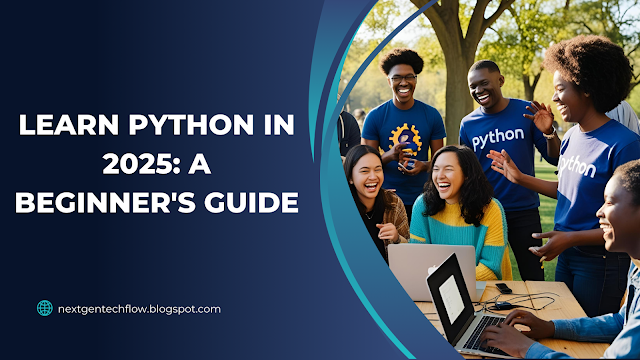 |
| Learn Python in 2025: A Beginner's Guide |
Python remains one of the most influential programming languages in 2025, powering everything from machine learning applications to web development, automation, and data science. As an accessible yet powerful language, Python provides a gateway for beginners to enter the world of programming with confidence.
In this comprehensive guide, we present a detailed, structured approach to mastering Python from scratch in 2025, leveraging the latest tools, trends, and best practices to ensure success.
Why Learn Python in 2025?
Python continues to dominate due to its:
-
Simple syntax that mimics natural language.
-
Versatility across various domains: AI, data science, web, finance, gaming, and more.
-
Massive community support and constant library updates.
-
Industry demand from top companies and startups.
Learning Python is a strategic investment in one’s career and digital fluency.
Setting Up the Python Environment in 2025
To begin coding in Python, we must first install and configure the tools needed for efficient development.
Install Python 3.12+
Ensure you’re using the latest stable release from python.org, which in 2025 is Python 3.12 or above. This version includes:
-
Enhanced pattern matching
-
Improved performance
-
Security enhancements
Choose an IDE or Text Editor
Select an integrated development environment (IDE) that suits your workflow:
-
VS Code (lightweight, with Python extension)
-
PyCharm (powerful and feature-rich)
-
Jupyter Notebook (ideal for data science and exploratory programming)
Set Up Virtual Environments
Use venv to isolate project dependencies:
This ensures clean, conflict-free development environments.
Python Basics for Absolute Beginners
Understanding the core building blocks of Python is essential for building more complex programs.
Variables and Data Types
Python is dynamically typed, so variable declarations are simple:
Control Structures
Conditional Statements
Loops
Functions
Reusable blocks of code:
Use default parameters, keyword arguments, and return values effectively.
Advanced Data Structures in Python
Python provides several built-in and advanced data structures for efficient data handling.
Lists
Ordered, mutable sequences:
Tuples
Ordered, immutable sequences:
Dictionaries
Key-value mappings:
Sets
Unordered collections of unique items:
Mastering these data structures is key for efficient algorithm design.
Object-Oriented Programming in Python
Python fully supports OOP, making it ideal for modeling real-world problems.
Classes and Objects
Inheritance, Encapsulation, and Polymorphism
Use inheritance to reuse and extend behavior:
Encapsulate data and expose only necessary functionality.
Error Handling and Debugging
Try-Except Blocks
Use try, except, finally, and custom exceptions to manage errors.
Logging and Debugging Tools
Utilize the logging module and tools like pdb and IDE-based debuggers for efficient troubleshooting.
Working with Files
File I/O is critical for data processing and automation.
Reading and Writing Text Files
JSON Handling
Python Modules and Packages
Organize code and reuse components using modules and packages.
Creating Modules
Import in other scripts:
Installing External Packages
Use pip:
Leverage packages like:
-
NumPy
-
Pandas
-
Flask
-
TensorFlow
-
BeautifulSoup
Web Development with Python
Python powers both backend and full-stack web apps.
Flask
A minimalist framework for quick API and web app development:
Django
A full-featured web framework with built-in admin, ORM, and templating.
Use Django for scalable apps with complex requirements.
Data Science and Machine Learning
Python dominates data science and AI workflows.
Essential Libraries
-
NumPy for numerical operations
-
Pandas for data manipulation
-
Matplotlib and Seaborn for visualization
-
Scikit-learn for machine learning
-
TensorFlow and PyTorch for deep learning
Typical Workflow
-
Load data with Pandas
-
Clean and preprocess
-
Visualize trends
-
Train/test models
-
Evaluate and tune
Automation and Scripting
Python excels at automating routine tasks.
Use Cases
-
Web scraping
-
File renaming
-
Email automation
-
Report generation
Example: Batch file renamer
Working with APIs
Use APIs to connect your Python apps with external services.
Using the Requests Library
Parse JSON responses and integrate with third-party platforms.
Testing Your Code
Use testing frameworks to ensure code quality.
Unit Testing
Run tests with:
Use pytest for more advanced testing needs.
Best Practices for Python Developers in 2025
-
Follow PEP 8 style guide
-
Write clean, modular code
-
Use type hints (
def func(a: int) -> str:) -
Document with docstrings
-
Version control with Git
-
Write tests before deploying
-
Stay updated with Python’s release cycle
Top Python Resources in 2025
Learning Platforms
-
freeCodeCamp
-
Coursera
-
Udemy
-
Educative
-
Real Python
Books
-
Automate the Boring Stuff with Python (2023 Edition)
-
Python Crash Course
-
Fluent Python
Communities
-
Stack Overflow
-
Reddit r/learnpython
-
GitHub
-
Discord and Slack channels
Build Real Projects to Cement Your Skills
Beginner Projects
-
To-do list CLI
-
Number guessing game
-
Currency converter
-
Web scraper
Intermediate Projects
-
REST API with Flask
-
Personal blog with Django
-
Weather dashboard with APIs
-
Image resizer tool
Advanced Projects
-
Chatbots using NLP
-
Machine learning predictive models
-
Web app with authentication
-
Portfolio site with Python backend
Preparing for Python Job Opportunities
Python developers are in high demand in 2025. Focus on:
-
Building a strong GitHub portfolio
-
Contributing to open-source projects
-
Completing certifications
-
Practicing coding challenges on LeetCode, HackerRank, Codewars
Conclusion: Your Python Journey Starts Now
Python in 2025 is more powerful, versatile, and in-demand than ever. Whether you're a complete beginner or switching careers, now is the perfect time to dive into this language. With structured learning, hands-on practice, and continuous project-building, you can master Python and unlock exciting opportunities across industries.
Stay consistent, keep experimenting, and push yourself to build real-world applications. The Python community is vast and welcoming—don’t hesitate to seek help and give back.
Let this guide be your launchpad toward becoming a proficient Python developer in 2025.

